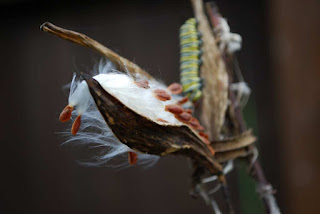The natural result of
this...
...surprisingly, turns out to be
this:
 |
| Monarch caterpillars. Lots of 'em. |
Before departing our humble abode, one or more of last month's monarch visitors laid eggs. This is one of the reasons why I like to have abundant landscaping in my yard: it's not just nice to look at in a passive sense - all kinds of interesting stuff happens out there. It's an entire story unfolding on a daily basis in a ridiculously-small suburban back yard and, of one gets off one's duff and actively starts looking around, a lot of that unfolding story becomes evident, and there's plenty of learning opportunity in it. I didn't know that monarchs actually bred and reproduced this far south. I thought they proceeded farther north on their
annual migrations before doing that.
I seemed to have had far more caterpillars than milkweed available to feed them, because they stripped the plant bare. That raised the obvious question: should I have culled the herd, leaving more milkweed available to a smaller number of individuals, or should I have let nature take its course?? Knowing very little about the life cycle of monarchs, I decided on the latter.
 |
| As the milkweed plants were getting stripped bare (they'll grow back from the roots), and the caterpillars began abandoning the urn of milkweed, presumably looking for more of it elsewhere. |
 |
| "Is there any good way down from this thing?!?!" |
 |
| This guy got one of the last available leaves. |
 |
| And this guy decided to eat his last leaf upside down. |
 |
| Notice how this guy had a larger yellow head and some larger sucker feet than the other individuals. I don't know why this is. Was he a different sub-species, did these differences represent the beginning stages of metamorphosis, or did this represent something else entirely? |
As of this morning, all of the caterpillars have vacated the now-stripped milkweed and have gone about their mysterious ways in doing whatever comes next for them. I don't know if any of them got enough nutrition to make it through their chrysalis stage. I was kinda hoping to see a few cocoons hanging around our yard because they're really neat...
 |
www.wikipedia.org
...and then toward the end of the metamorphosis, you start seeing the butterfly forming within. |
So perhaps if I get lucky, I'll find a coccoon or two somewhere in our yard in the next week or two (how far can caterpillars travel from a host plant before they have to hunker down for their change of life??). And within a few more months, hopefully I'll have more milkweed.











No comments:
Post a Comment
I'm forced to moderate comments because the spammers have become too much for me to keep up with. If you have a legitimate comment, I will post it promptly. Sorry for the inconvenience.